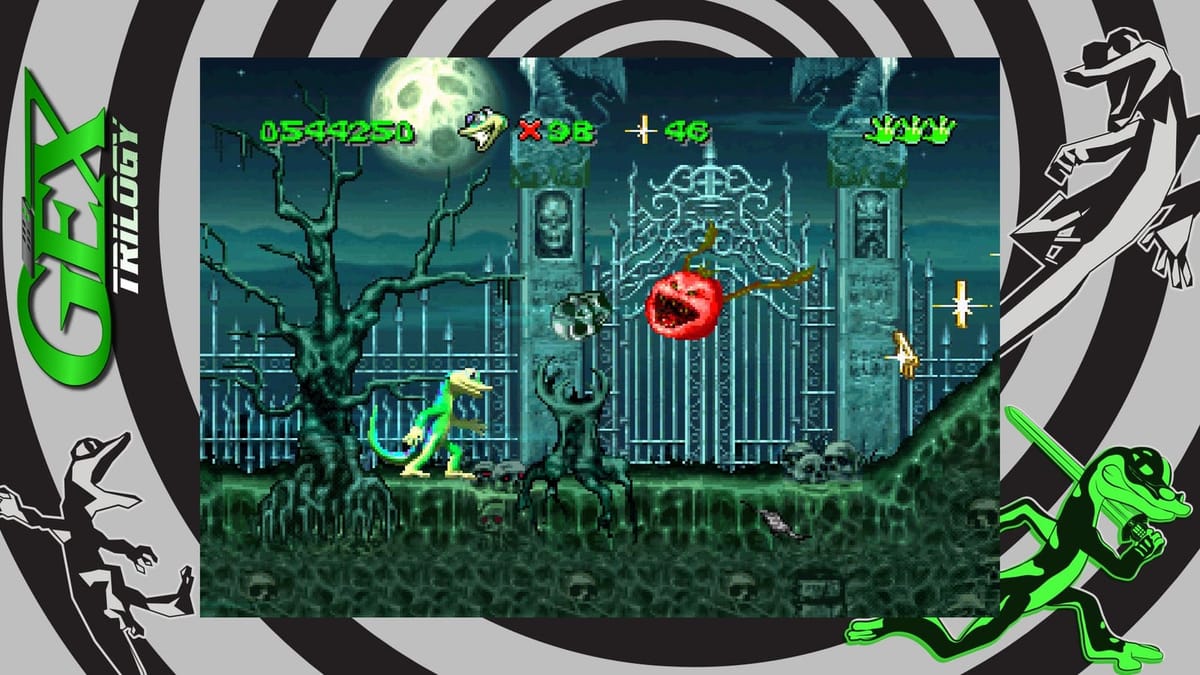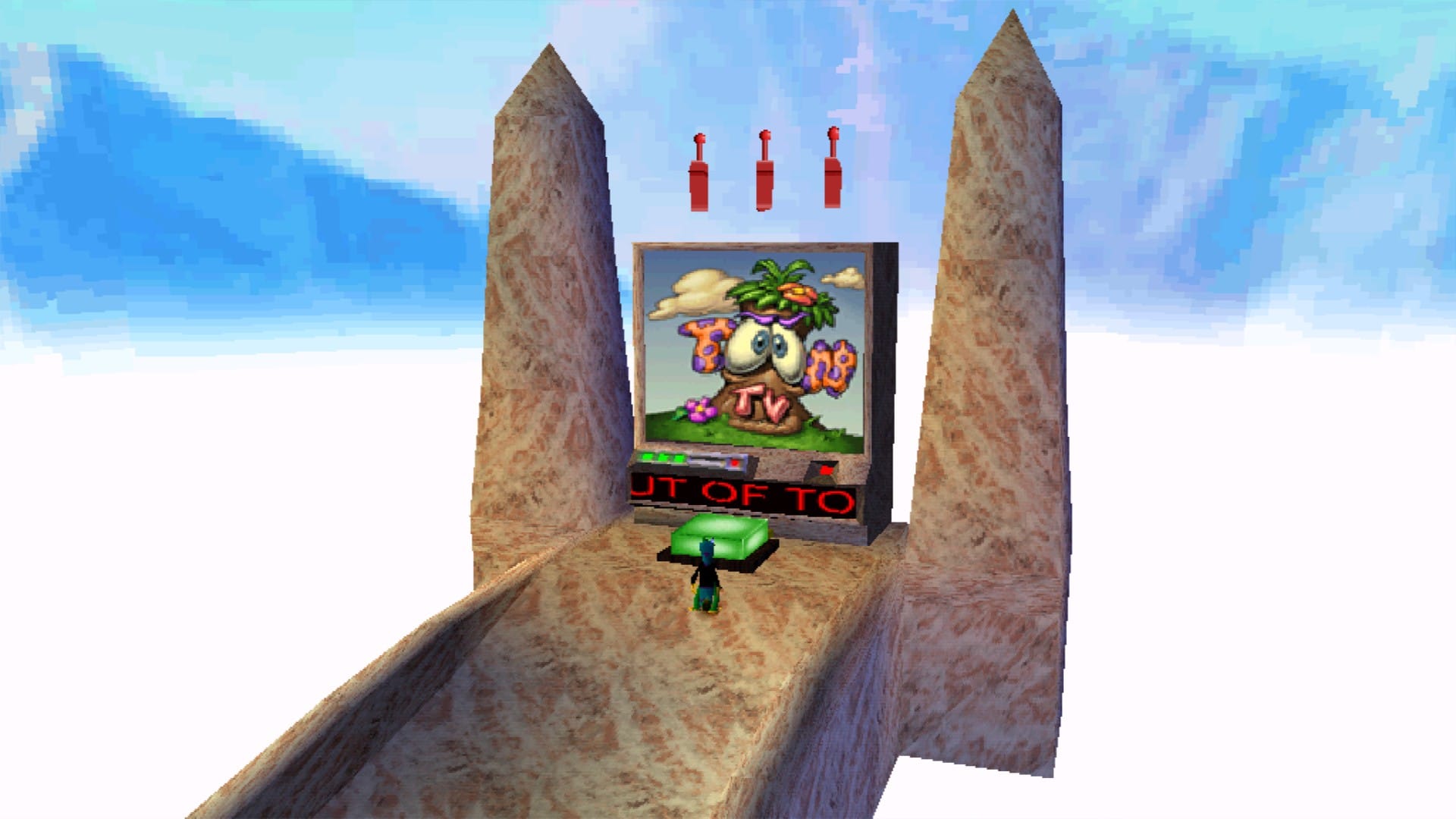
Remember the 90’s? Y’know, all grunge bands, denim jeans and newfangled inventions like the internet? If not, don’t fear, Gex has got your back! He remembers the 90’s fondly, and is eager to throw more than a couple of pop culture one-liners your way to refresh your memory. The quippy, channel-surfing gecko may well be in his 30th year, but he’s as energetic as ever in the new Gex Trilogy, coming to us courtesy of Limited Run Games.
The release packages together original 2D side-scroller Gex (1995) along with 3D platformers Gex: Enter The Gecko (1998) and Gex 3: Deep Cover Gecko (1999). Granted, that’s a lot of gecko to get through, but I’ve spent enough time with Gex Trilogy now to tentatively call myself Gaming Trend’s resident Gexpert and, at risk of showing my cards too early, I’ve had an absolute blast.
Let’s start with some of the brand new features that Gex Trilogy brings to the table, the majority of which are integrated across all three games. The most practically useful of these is arguably the newly implemented saving system, which players can take full advantage of no matter which Gex game they choose to dive into. Long past are the days of memory cards and passwords as the saving system has now been modernised, allowing you to manually save in up to three save slots. You can do this at any point by clicking R3 (on Playstation), which brings up a sleek and stylish overlay menu that also has various other options you can pick. Yes, it’s something you’d expect from any modern release, but it’s a convenient inclusion and you can save anywhere, whether you’re snowboarding down the side of a mountain or tail-bouncing a particularly aggressive tomato.
Gex Trilogy also includes a rewind feature, something which I’ve come across many times in games on PS Plus’ Classics Catalogue. Essentially, it allows you to instantly rewind gameplay up to a certain point by pressing the triggers down (L2 and R2). Suffice it to say that this can be extremely useful when Gex decides that he has had enough of jumping for the day and instead runs headfirst off the edge of a platform despite my insistence that I indeed pressed X. I cannot sing this feature’s praise enough, as it does wonders in mitigating the more janky parts of what are at this point 25-to-30 year old games and, by proxy, take the edge off any frustrations that can arise during gameplay.
Additionally, a goldmine of content has been included in the ‘Gextras’ section which is bound to get any longtime fan of the series Gexcited. Accessible from the main menu, the amount of goodies on display here is frankly impressive, including trailers, concept art, game manuals and even a new interview with the voice of Gex himself Dana Gould. There is a dedicated section for the soundtracks of the games where you can rock out to your favourite themes and you can even watch demo footage from the colloquially-named Gex Jr game which never saw the light of day. Admittedly, I do not have any personal nostalgia for the series, but even I can tell that a large amount of thought and care has been put into curating this extra material, and I thoroughly enjoyed my time digging into it all.

Now, onto the games themselves, and it makes sense to start at the beginning. Originally released in 1995, Gex is a 2D side-scrolling platformer and sees the eponymous gecko on a mission to escape the Media Dimension after being sucked through his TV by evil cyber overlord Rez. At least, that’s what I gathered from the CG intro, and after cutting to black it was quickly onto tail-spinning my way across the Media Dimension in search of remotes to unlock more levels and worlds. I’m of course being facetious about the lack of detailed plot here, as Gex is the kind of game that lives and dies on its gameplay. Saying that though, I was surprised to discover a relatively fleshed out prologue to the game’s events as I was sifting through the digital manual, so the plot is there if you’re willing to search for it.
Back to gameplay, what struck me the most was the sheer creativity on display. Gex’s species is integrated brilliantly into his moveset, from a tongue lash for gobbling up powerup orbs and a tail spin for batting off enemies to a tail bounce for extra height and suction cups for wall/ceiling traversal. This extends to the world-by-world gameplay also, which sees you bouncing on theatre scenery, flipping levels between day or night and controlling rockets mid-flight to name but a few. And this creativity and variety just keeps coming. Take the boss levels, for example, which see you doing anything from avoiding a giant dragon worm creature as you climb a sheer rock face to dropping anvils on an out-of-shape superhero called The Flatulator. The basic enemies are just as well-designed, and feel appropriate to the themed channels that they inhabit as you travel from genre to genre in search of more remotes. There are also powerups that take the forms of various bugs that Gex can gulp down using his tongue lash, and can give anything from more health and extra lives to invulnerability and fire breath. The variety does come with a cost however, as the game gives you very little in the way of an introduction to new enemies or obstacles, forcing you to tank a couple of lives in order to learn enemy placements and boss patterns. I don’t feel this is simply a case of this gecko gittin’ gud either, as the unpredictability mixed with the restricted ability to see what’s coming up ahead creates somewhat of an unfair expectation for precognition. The previously mentioned rewind feature comes in clutch here and does, admittedly, alleviate this added pressure.
It has to be said that Gex himself is full of character, and even that is probably an understatement. What could have easily just been a run-of-the-mill platform mascot oozes with colour and personality, and the influence and performance of Gould is the main driving force. Again, there is an impressive variety of voice lines to listen to, and they are funny for the most part, which is important considering the analogous connection between the Gex series and pop-culture comedy. I do concede that it could become grating, especially if these types of jokes are not your cup of tea, but I personally never found myself tiring of it and looked forward to what new quips Gex would come out with whenever I unlocked a new world.
This does bring me on to the shakiest element of Gex Trilogy: its humour. Now, I’m no prude, and many of the risque jokes and quips tow the line between crassness, intelligent observation and acceptability, it’s just that some really don’t and that’s a problem. Even Limited Run Games themselves acknowledge this fact as, on booting up the game, they have included a disclaimer explaining their philosophy of game preservation and that, as a result, “some games may be products of their time and contain content that could be considered offensive”. It is reassuring to see that the company has thought about this and has balanced the noble cause of game preservation with the importance of acknowledging certain material that perpetuates dated ideas. I absolutely think that this was the right play from Limited Run in adding to the modern discourse whilst also maintaining the spirit and integrity of the original games.

Jumping to the tail end of the 90s, Gex: Enter The Gecko and Gex 3: Deep Cover Gecko released in 1998 and 1999 respectively, and saw our favourite TV-loving reptile make the jump to 3D. Gex: Enter The Gecko sees our hero hired by the government to stop his arch nemesis Rez, who is up to his old tricks in the Media Dimension. In a nutshell, it is everything from Gex on a grander scale and an extra dimension for good measure. The sheer variety on display remains, in enemies, bosses, and worlds, the latter of which are now expansive and full of collectables. The progression also becomes much more dynamic. Each level has three red remotes (main objectives) and two silver remotes (collectables and hidden) to collect. You choose which main objective you want to pursue prior to entering the level a la Super Mario 64, so you’ll find yourself needing to replay levels to collect more remotes and, in turn, unlock more of the hub area to explore which also holds more levels. Replayability is far from a problem however, as you’ll find plenty to do in the sprawling levels as you complete different objectives and search hidden areas for collectables. It feels like a natural progression from its predecessor, and Gex: Enter The Gecko does a brilliant job of stemming the aggressive linearity of the first game whilst also effectively guiding the player toward progressing down the critical path. For any fellow completionists out there, the game also rewards the player for scouring every nook and cranny for those silver remotes, which unlock bonus levels that have their own unique objectives and gameplay.
It needs to be said that the transition to 3D was not a smooth one visually for many a mascot platformer, and Gex was no exception, with Gex: Enter The Gecko’s CG intro and general gameplay looking a tad worse for wear. Despite this, I don’t think this marks the game down considering its age and the fact that it doesn’t look markedly worse compared to its peers. The camera can be fiddly also, feeling heavy and sluggish to move and it frequently snags on the environment during the trickier platforming sections. Saying that, the jump to 3D has also eliminated the frustration in Gex caused by enemy/hazard placement and being able to see ahead, along with sanding down the difficulty drastically. This never felt tedious though, as the gameplay and environment variety kept me on my toes. Gex’s abilities have been predominantly kept as is, with the addition of a flying karate kick which, whilst a combat move, I found much more useful in traversing quickly through the expansive hub world and levels. Also, powerups are back, gotten from smashing small TVs and eating the flies that escape. Again, nothing much has changed here, although some powerups can be essential to completing certain stages.

In Gex 3: Deep Cover Gecko, Gex must once again enter the Media Dimension to save his partner Agent Xtra from the clutches of Rez. The game could quite reasonably be described as Gex: Enter The Gecko expanded, with it looking, playing and feeling very similarly. I don’t want to do Gex 3 a disservice, as it is just as varied, sprawling and replayable as its predecessor and, in isolation, is a perfectly solid 3D platformer with enough to keep you entertained. Playing it directly after the last one however does reveal that the modus operandi here is one of continuation and not innovation. Still, it’s a repeat of a formula that works, and it does include some additions. For one, Gex can now swim and glide in certain levels, and can also pilot vehicles and mounts, including snowboards, a kangaroo and a tank. The hub world is now Gex’s very own Batcave, complete with his very own English butler called Alfred, albeit this one is a tortoise. Alfred also appears throughout the game to give hints, and is even playable in bonus levels, along with new characters Rex and Cuz. As stated though, these other characters are only playable in the bonus levels, so it is not quite as extensive of a feature as similar ones from Gex’s contemporaries like, for example, Spyro: Year of the Dragon, which only released a year later.
In terms of progression, it’s mostly the same rodeo with a few tweaks. Collect red remotes (four in each level) to open up the hub world and access more levels. Three of the remotes are rewarded for completing objectives with the fourth for collecting all 100 Bugcoins located in each level. The latter is made slightly harder than in the last game by way of there being only 100 Bugcoins in each level to pick up, so you will find yourself karate-kicking across the levels from end-to-end in search of that one last bug. New collectables have also been added however, with pawprints rewarding permanent health upgrades and coins unlocking bonus levels. Agent Xtra is the only live-action character present, and is portrayed by Marliece Andrada of Baywatch fame. Look, even considering that the Gex series holds itself with its tongue firmly placed in its cheek, the scenes between Xtra and Gex are painful to watch. Andrada’s performance is stilted and awkward, and the scenes really boil down to her standing in front of a greenscreen whilst Gex hurls sexual innuendos at her. From the dialogue and costume she’s given to her status as the MacGuffin of the plot, it is pretty clear why she is included and it does leave a bad taste in the mouth. Thankfully, these scenes are brief, so you can quickly get back to the rest of the game, which is otherwise fun and engaging.
All in all, Gex Trilogy is a really engaging and fun Gexperience for fans and newcomers alike, lovingly brought to modern consoles by Limited Run Games. It will be very interesting to see where Square Enix takes the IP next as this collection proves that, with some tweaks and a modern makeover, there may well be a gecko-shaped hole for Gex to fill in the future.
Gex Trilogy
Great
Gex Trilogy is a must-play for longtime fans of the series, and a brilliant introduction for newcomers, being a perfect way to definitely experience everything Gex has to offer. The three games in this collection are strikingly varied, frenetically engaging and are oozing with personality. Games from decades past they may well be, but Limited Run Games have done a spectacular job of balancing the preservation of their original essence with the addition of modern gameplay features.
Pros
- Bundles of extra content for longtime fans, curated with genuine care
- New modern features like revamped save system and rewind feature
- Sheer variety of gameplay features
- Colourful character with unique moveset
- Great level and enemy designs
Cons
- Some elements, such as certain jokes and characters, do not land and perpetuate dated ideas
- Janky and sluggish camera controls in Gex: Enter The Gecko & Gex 3: Deep Cover Gecko
- Somewhat unfair enemy and hazard placements in Gex
This review is based on a retail PS5 copy provided by the publisher.
